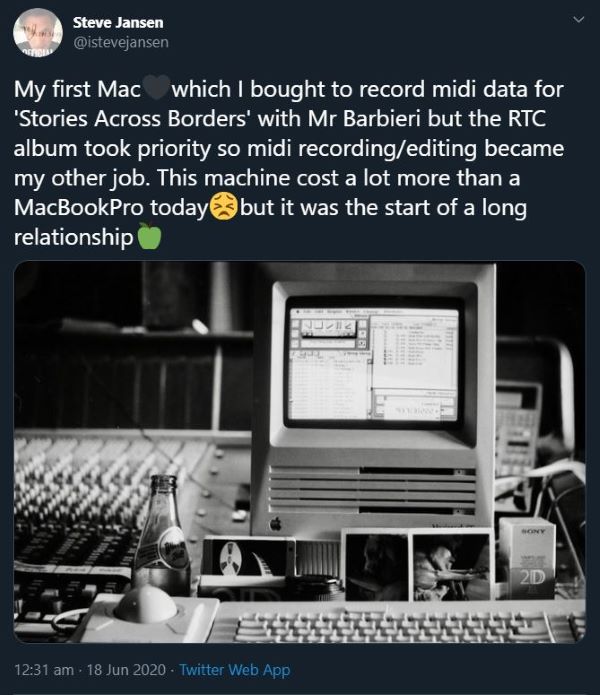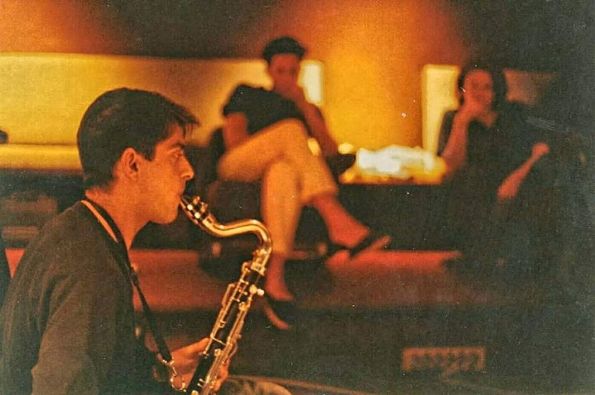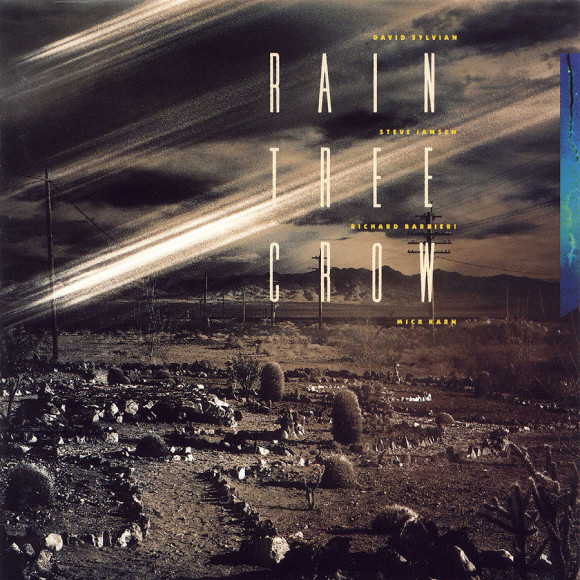Following their excursion into commercial pop territory with The Dolphin Brothers, Steve Jansen and Richard Barbieri’s next joint project was set to take a very different direction. ‘We try to alternate our recordings in terms of types of album,’ explained Jansen. ‘Our first album [Worlds in a Small Room] was instrumental, the next vocal; so this should have been instrumental. Also, the record company weren’t budgeting enough for a vocal album, which requires studio time. If they had said, “do another vocal album, here’s the budget,” we’d have done it. But we were quite happy not to.’
In 1989, with a modest budget of £10,000 from Virgin’s subsidiary Venture label, the pair set about the creation of what would ultimately become Stories Across Borders. It was a new experience, said Barbieri: ‘We’ve never recorded on a small scale before, from our first [Japan] album we always had a lot of time in top studios.’ However, there was a certain challenge in a fresh approach. Jansen: ‘We’ve had enough time in studios that we know what we want to achieve, and we wanted to try and do it with limited equipment.’
The answer was to spend the record company’s money on technology and to work for the most part outside of an established studio environment. So, they purchased a Soundtracs 16 track desk, a Fostex reel-to-reel analogue tape recorder also with 16 tracks, a Mac SE – resplendent with dual floppy drives – to handle the Performer software, and a DAT machine for the mastering. Supplemented by their existing gear and other kit bought at their own expense, they now had a set-up to see the project through.
At this point there was a very significant diversion. ‘The deal was done and we’d bought the equipment. We’d done some writing, but we hadn’t got down to any recording,’ remembers Steve. ‘We started doing some work in Italy, and it was when we were over there that the Rain Tree Crow project came up.’
Whilst Jansen/Barbieri were contributing to Alice’s album Il Sole Nella Pioggia, ‘Mick and Dave got together and started talking about what they wanted to do. They were really keen to see everyone working together again. We were surprised, but we got this phone call saying, “it looks like it could happen”.’ The record company was the same for both projects, so the change of plan could be accommodated without complication; ‘Virgin were all for it, and it took priority, so we came back over here to do that.’ (SJ)
The budget for the re-formation of Japan was far in excess of what half the band had just been working with, despite David Sylvian’s stipulation that their original name could not be used to promote the new material. Barbieri: ‘I’m really surprised we got a preferential contract when they knew we weren’t going to call it Japan. There was a lot of pressure from them for us to do that, but we’d got David at the other end wanting it in the contract that the name wouldn’t be used. We thought once that happened they’d offer us less money, less time to do the album, less of a deal… But they still gave us a good deal, so we can’t complain.’
In fact, a quarter of a million pounds was put behind the project, allowing the recording sessions to move from studio to studio and from country to country. They started at Miraval in France, moved on to Condulmer in Italy, then back to the UK for time in London and at Wool Hall in Bath. Money meant time, and time allowed material to be teased out through improvisation, the core concept that had sparked the reunion.
Steve: ‘This was all new to all of us because there was no material and we had to come up with something as a band. There was no pre-production, it was all written on the spur of the moment, so what was improvisation was also writing. There were no ideas, nobody had any ideas ready, it was just plug in and play.’
‘At the end we had hours and hours of material that we had to listen to,’ Richard explained. ‘Some things we kept as the basis of a track, other things we thought, “it’s working well here, but we need to concentrate more on this part,” so we’d go back and re-record that.’
The set-up for laying down the recording was somewhat more complex than the 16-track arrangement that Jansen and Barbieri had left behind. Steve: ‘It was 64-track recording for most of the tracks. Two Mitsubishi 32-track digital machines running together.’ It certainly wasn’t possible to act as both musician and technician as would be the case for Stories Across Borders. Richard: ‘It was something of a job for the engineer, he had almost every track permanently on record. There was stereo from every keyboard, Steve had about 12 tracks…’
One aspect of the low-cost ‘home’ set up was the same, however: the Mac and its Performer software. ‘All my keyboards and Dave’s keyboards were going to a Macintosh that Steve was controlling,’ continues Richard. ‘When we were playing live it was just receiving MIDI information from the keyboards, but it gave us the opportunity at a later date to go back over, say, four hours of music and find thirty minutes that we liked and keep it in its original form and reconstruct around it. And that’s the only way we used any sequencing.’

‘New Moon at Red Deer Wallow’ features just the band members, no supplementary orchestration or ornamentation from guest soloists. The essence of the project is captured in the interplay between four musicians. Dark atmospherics open up; the black of the night sky as backdrop for furtive nocturnal mutterings and movements brought to life through the band’s ingenuity. Hearing the range of synthesiser sounds and the myriad drum-skin strikes, textures and timbres in the percussion part, it’s easy to appreciate why so many tracks were needed in the studio to capture such intricacy. Yet the mix never sounds crowded, quite the opposite in fact; at times a silence hangs momentarily waiting for the next interjection.
Mick Karn’s bass guitar may be uncharacteristically muted on this record by the prior standards of Japan, but here his bass clarinet playing gives us the lead. In earlier times he’d talked about a concept of the bass guitar being up-front like a singer, and here the vision is fulfilled in woodwind. Mick explores the reach of the instrument as deep and resonant reedy pulses give way to stifled squeals. I love the vitality of his performance. Play it loud and hear his breath controlling those notes. It brings him right into the room, which is indescribably special.

Steve Jansen described the genesis of ‘New Moon…’: ‘Originally when we came up with the mood we had all moved between instruments. I was playing bass synth and I think Mick was playing bass clarinet and keyboards, with Dave on guitar. So we were purely playing around with notations and melodies and there wasn’t any rhythm. Then when we realised something was happening we needed some interesting percussion.
‘I’d brought with me a load of ethnic drums, so I built up a percussion track about five or six minutes long. It was all layered and started off with a Moroccan “buzz” drum as a foundation.’ The instrument was ‘a clay drum with gut strings underneath.
‘We’d improvised a rough version of the song and decided that was the sort of mood we wanted, and I needed to work out an interesting percussion layout, a sort of atmosphere to sit on.
‘So I got the click track up to the tempo and basically just improvised on 3 or 4 different drums.’ These included ‘some other smaller Indian clay drums which were harmonised for this stereo continuation, and then some Japanese silk fans which if you hit with a pencil close to the microphone you get this wonderful tone. I used two of those so they were like fighting each other.’
Much of the craft was in taking away what wasn’t necessary. ‘A lot of it was erasable. I spent about a day and a half erasing the cr*p and leaving the selective parts that worked. So the end result sounds like somebody who knows what he’s doing! It’s just improvising against yourself. You play one thing, and then play back to it,’ said Steve.
‘So the percussion track was built up in that way, and what was going on in the original jam was then re-created over the new percussion track.’
David Sylvian: ‘I think of Steve as an “architectural” drummer – he builds these really firm foundations which he maps out before he begins to play them. So he had to come up with ways of deceiving himself in a sense, so that he could improvise and play against himself, which is what he ended up doing, by going into the studio and picking up one drum, playing that onto tape and then improvising against himself, and so on. This is what we did on the track ‘New Moon At Red Deer Wallow’ for example, and after two days we had built up a percussion track that Richard, Mick and myself then went in and improvised on top of – it was quite an interesting way of working.’
For Sylvian, the result was the epitome of Rain Tree Crow. “New Moon at Red Deer Wallow’ I think is really exceptional. I feel the track realises the potential that this group always had that was never realised before. For me this is the first time, and maybe the last time it will be. And I’m happy; I don’t mind if it’s the last time because it’s there, and I’m very happy with that piece of music. If it was that piece of music alone that came out of these sessions I’d be happy. It would justify the recording process, it would justify this project.’
The fractious end to the creation of the Rain Tree Crow album left Jansen and Barbieri free to return to the more modest setting for their duo project whilst the mixes for RTC were worked on by Sylvian apart from the rest of the group. ‘Rain Tree Crow finished recording in April [1990], and we went and started our own thing in Italy in June’ (SJ). Contacts made through their work with Alice (thanked under her birth-name of Carla Bissi on the final album credits) led to them being offered a space in Italy in which to record.

It’s fascinating listening to Stories Across Borders in the knowledge that its history is so interlinked with Rain Tree Crow. The development of the pieces was in some cases akin to the way they had just been working with David Sylvian and Mick Karn. ‘We each had two tracks prepared, and the other four were improvised when we got together,’ recalled Richard Barbieri in a joint interview when the album was released. ‘The stuff in Italy was definitely “plug in and see what happens”,’ added Steve. ‘We’d lay some drums down, and that would suggest a mood or whatever. We work on an emotional level, rather than articulating what a song’s about.’ Once again, they were taking cues from one another. Richard: ‘I think we respond quite well to the direction a track can take. It can go in a different direction if Steve does something quite drastic, then I’ll go in that direction because I know it’s working.’

For two of the instrumentals on Stories Across Borders, a third member of Japan/RTC joined them. Mick Karn participates on both the opening ‘Long Tales, Tall Shadows’ and ‘The Insomniac’s Bed’. I enjoy pairing the latter with ‘New Moon at Red Deer Wallow’. Mick’s bass clarinet and saxophone were recorded in a brief session at their old stomping ground of the Manor Studios in Oxford (owned by Virgin so the expense was minimal), and there’s a consistent spirit with the music they had crafted together in the preceding months. Here Mick shares the lead with a piano melody composed by Steve.
In part because of its history, bookending the major undertaking of Rain Tree Crow, the creators of Stories… struggled to see a consistency in their work. ‘The album title comes from the way in which we were working,’ Steve explained. ‘To us each track was a different story, but because there was so much time in between, it was hardly a session. Each piece has its own atmosphere, so there was no real continuity. We couldn’t think of a way of presenting the album, after the fact, that really summed it all up, so the title came from the way we recorded it. The song titles are suggested by the moods.’
‘New Moon at Red Deer Wallow’
Richard Barbieri – synthesisers; Steve Jansen – Moroccan clay drums, fan drums, percussion; Mick Karn – bass clarinet; David Sylvian – guitars, bass
Music by Rain Tree Crow
Produced by Rain Tree Crow. From Rain Tree Crow by Rain Tree Crow, Virgin, 1991.
Engineered by Pat McCarthy. Mixed by David Sylvian and Pat McCarthy at Eel Pie Studios, London.
Computer programming by Steve Jansen. Keyboard programming by Richard Barbieri and David Sylvian.
Recorded between September 1989 and April 1990 at Miraval Studios, Le Val, France; Condulmer Studio, Zerman di Mogliano, Italy; Marcus Studios, London; Air Studios, London; The Wool Hall, Bath; Ropewalk Studio, Dublin; Mega Studios, Paris, France; Eel Pie Studios, London.
Download link: ‘New Moon at Red Deer Wallow’ (iTunes); ‘The Insomniac’s Bed’ (iTunes)
Physical media: Rain Tree Crow (cd – Amazon); Stories Across Borders (Amazon).
The featured image is a panel from the Rain Tree Crow 2003 re-release cd digipack, portrait photography by the Douglas Brothers. Thank you to Richard Barbieri for permission to use his photograph of Mick Karn taken during the Rain Tree Crow sessions.
All artist quotes in this article are from interviews in 1991/2. Full sources and acknowledgements can be found here.
‘One of the strangest tracks – there were definitely some original things happening there, like free-form but not jazz.’ Richard Barbieri on ‘New Moon at Red Deer Wallow’, 1991

More about Rain Tree Crow:
Red Earth (as summertime ends)
Blackcrow Hits Shoe Shine City

Legends all of you. A masterpiece.
LikeLiked by 1 person
I’ll just run off now and put on Rain Tree Crow. Thank you for the post as now I am informed about Stories Across Borders, next visit iTunes.
LikeLiked by 1 person
ps who did the cover of Stories Across Borders?
LikeLike
Mat Maitland is credited with design and I believe he was responsible for the images.
LikeLike
Thank you
LikeLiked by 1 person
Great post, as always. I look forward to these every 3 weeks! I have been wondering recently what RTC would have sounded like had the members isolated themselves somewhere, sometime in 1982, and proceeded to record the 6th consecutive Japan album.
LikeLiked by 1 person
Interesting details on how the budget, or lack of it, shapes the construction of tracks
LikeLiked by 1 person